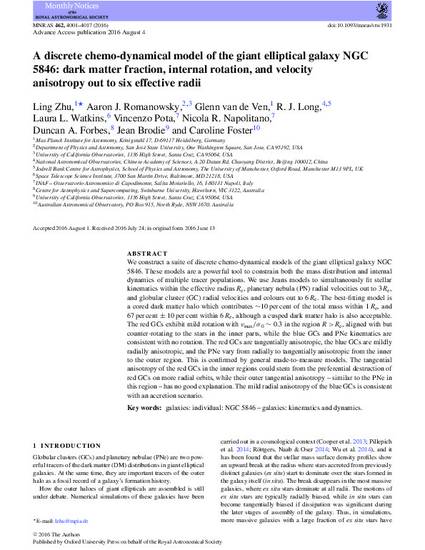
Article
A discrete chemo-dynamical model of the giant elliptical galaxy NGC 5846: dark matter fraction, internal rotation, and velocity anisotropy out to six effective radii
Monthly Notices of the Royal Astronomical Society
(2016)
Abstract
We construct a suite of discrete chemo-dynamical models of the giant elliptical galaxy NGC 5846. These models are a powerful tool to constrain both the mass distribution and internal dynamics of multiple tracer populations. We use Jeans models to simultaneously fit stellar kinematics within the effective radius Re, planetary nebula (PN) radial velocities out to 3 Re, and globular cluster (GC) radial velocities and colours out to 6 Re. The best-fitting model is a cored dark matter halo which contributes ∼10 per cent of the total mass within 1 Re, and 67 per cent ± 10 per cent within 6 Re, although a cusped dark matter halo is also acceptable. The red GCs exhibit mild rotation with vmax/σ0 ∼ 0.3 in the region R > Re, aligned with but counter-rotating to the stars in the inner parts, while the blue GCs and PNe kinematics are consistent with no rotation. The red GCs are tangentially anisotropic, the blue GCs are mildly radially anisotropic, and the PNe vary from radially to tangentially anisotropic from the inner to the outer region. This is confirmed by general made-to-measure models. The tangential anisotropy of the red GCs in the inner regions could stem from the preferential destruction of red GCs on more radial orbits, while their outer tangential anisotropy – similar to the PNe in this region – has no good explanation. The mild radial anisotropy of the blue GCs is consistent with an accretion scenario.
Keywords
- galaxies: individual: NGC 5846,
- galaxies: kinematics and dynamics
Disciplines
Publication Date
November, 2016
DOI
10.1093/mnras/stw1931
Publisher Statement
This article has been accepted for publication in Monthly Notices of the Royal Astronomical Society ©: 2016 The Authors. Published by Oxford University Press on behalf of the Royal Astronomical Society. All rights reserved.
This article is also available online at the following link: http://dx.doi.org/10.1093/mnras/stw1931
Citation Information
Ling Zhu, Aaron J. Romanowsky, Glenn van de Ven, R. J. Long, et al.. "A discrete chemo-dynamical model of the giant elliptical galaxy NGC 5846: dark matter fraction, internal rotation, and velocity anisotropy out to six effective radii" Monthly Notices of the Royal Astronomical Society Vol. 462 Iss. 4 (2016) p. 4001 - 4017 ISSN: 1365-2966 Available at: http://works.bepress.com/aaron_romanowsky/96/
